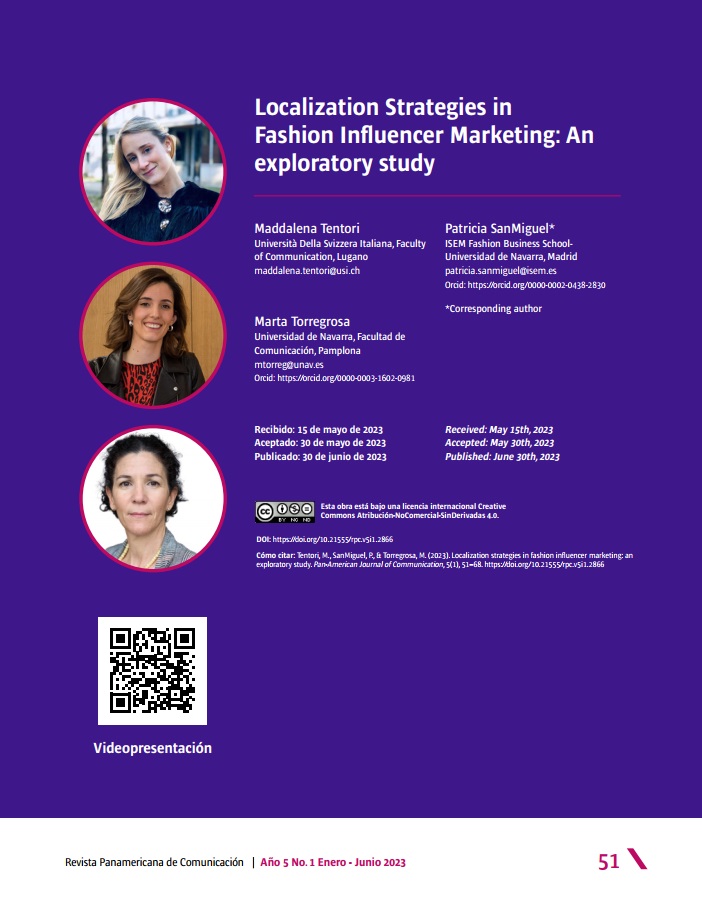Estrategias de localización en el marketing de influencers de moda: un estudio exploratorio
Contenido principal del artículo
Resumen
Internet es un entorno sin fronteras espacio-temporales, donde las marcas de moda se conectan con sus consumidores, especialmente a través de las redes sociales. Instagram, TikTok o YouTube se han convertido en los canales preferentes para establecer una comunicación personal y bidireccional con los seguidores y al mismo tiempo en un canal de comunicación comercial. Una de las estrategias de marketing en redes sociales que más están utilizando las marcas de moda es el marketing de influencia. En los últimos años los estudios académicos en relación con el marketing de influencia han aumentado notablemente. Sin embargo, la literatura muestra que todavía son muchos los gaps existentes en los que es conveniente desarrollar estudios. En este sentido, los profesionales del marketing se encuentran con frecuencia ante la disyuntiva de realizar campañas con influencers globales o por el contrario localizar sus estrategias utilizando influencers de los países, ciudades o área donde se va desarrollar la campaña de comunicación y marketing, permitiendo una mejor interacción con el idioma, las costumbres y cultura del público objetivo. Este estudio exploratorio tiene como objetivo profundizar en la relación entre el marketing de influencia y las estrategias de localización. Para ello, se analiza las estrategias de influencer marketing de cuatro marcas de moda y lifestyle (Sephora, APM, H&M y Dolce & Gabbana) observando el enfoque global o local de sus acciones y sus consecuencias.
Detalles del artículo
Sección

Esta obra está bajo una licencia internacional Creative Commons Atribución-NoComercial-SinDerivadas 4.0.
Cómo citar
Referencias
» Andrade, A. D. (2009). Interpretive research aiming at theory building: Adopting and adapting the case study design. The qualitative report, 14(1), 42.
» Borchers, Nils S. 2019. “Editorial: Social Media Influencers in Strategic Communication.” nternational Journal of Strategic Communication 13 (4): 255–60. https://doi.org/10.1080/1553118X.2019.1634075
» Cheon, H. J., Cho, C. H., & Sutherland, J. (2007). A meta-analysis of studies on the determinants of standardization and localization of international marketing and advertising strategies. Journal of International Consumer Marketing, 19(4), 109-147.
» Dodson, I. (2016). The art of digital marketing: the definitive guide to creating strategic, targeted, and measurable online campaigns. John Wiley & Sons.
» Ewers, N. L. (2017). # sponsored–Influencer Marketing on Instagram: An Analysis of the Effects of Sponsorship Disclosure, Product Placement, Type of Influencer and their Interplay on Consumer Responses (Master’s thesis, University of Twente).
» Fan, S., Hansen, M. E., Lo, Y., & Tishkoff, S. A. (2016). Going global by adapting local: A review of recent human adaptation. Science, 354(6308), 54-59.
» Femenia-Serra, F., Gretzel, U., & Alzua-Sorzabal, A. (2022). Instagram travel influencers in# quarantine: Communicative practices and roles during COVID-19. Tourism Management, 89, 104454.
» Francisco, E., Fardos, N., Bhatt, A., & Bizel, G. (2021). Impact of the COVID-19 Pandemic on Instagram and Influencer Marketing. International Journal of Marketing Studies, 13(2), 20-35.
» Influencer.com, and Globalwebindesx.com. 2020. “The Age of Influence: How COVID-19 Has Propelled Brands into the Era of Influencer Marketing.” https://www.influencer.com/research-report-influencer
» Jacobson, J., & Harrison, B. (2022). Sustainable fashion social media influencers and content creation calibration. International Journal of advertising, 41(1), 150-177.
» Jaradat, A., Mohamad, N. A., Asadullah, A., & Ebrahim, S. (2015). Issues in Location Based Marketing: A Review of Literature. International Journal of Scientific and Research Publications, 5(1), 1-4.
» Kapferer, J. N., & Bastien, V. (2009). The specificity of luxury management: Turning marketing upside down. Journal of Brand management, 16(5-6), 311-322.
» Kura, M. (2020) What Is Content Localization? How To Build a Strategy. At : https://www.semrush.com/blog/web-localization-strategy-how-to-localize-content-like-a-marketer/
» Li, Yung-Ming, Cheng-Yang Lai, and Ching-Wen Chen. 2011. “Discovering Influencers for Marketing in the Blogosphere.” Information Sciences 181 (23): 5143–57. https://doi.org/10.1016/j.ins.2011.07.023
» LISA. (2007). The Localization Industry Primer. An introduction to preparing your business and products for suc- cess in international markets. Romainmôtier: Localization Industry Standards Association.
» Munro,G.(2019)”How brands can localize their visual content strategy at a global scale” WARC. See at https://www.warc.com/content/article/bestprac/how_brands_can_localise_their_visual_content_strategy_at_a_global_scale/127197
» Liu, S., Perry, P., Moore, C., & Warnaby, G. (2016). The standardization-localization dilemma of brand communications for luxury fashion retailers’ internationalization into China. Journal of Business Research, 69(1), 357-364.
» Noris, A., SanMiguel, P., & Cantoni, L. (2020). Localization and cultural adaptation on the web: An explorative study in the fashion domain. In HCI in Business, Government and Organizations: 7th International Conference, HCIBGO 2020, Held as Part of the 22nd HCI International Conference, HCII 2020, Copenhagen, Denmark, July 19–24, 2020, Proceedings 22 (pp. 474-492). Springer International Publishing.
» Pym, A (2012). Website Localizations. Oxford University Press.
» Quelhas-Brito, P., Brandão, A., Gadekar, M., & Castelo-Branco, S. (2020). Diffusing fashion information by social media fashion influencers: understanding antecedents and consequences. Journal of Fashion Marketing and Management: An International Journal, 24(2), 137-152.
» SanMiguel, Patricia. 2020. Influencer Marketing: Conecta Tu Marca Con Tu Público. 1a ed. Acción Empresarial. Editorial Almuzara.
» SanMiguel, Patricia, Simone Guercini, and Teresa Sádaba. 2019. “The Impact of Attitudes towards Influencers amongst Millennial Fashion Buyers.” Studies in Communication Sciences 18 (2): 439–60. https://doi.org/10.24434/j.scoms.2018.02.016.
» Saravanakumar, M., & SuganthaLakshmi, T. (2012). Social media marketing. Life science journal, 9(4), 4444-4451.
» Sheridan, M., Moore, C., & Nobbs, K. (2006). Fast fashion requires fast marketing: The role of category management in fast fashion positioning. Journal of Fashion Marketing and Management: An International Journal.
» Shu Wei Ting, D., Carin,L., Dzau,V., & Wong,Y.(2020) ”Digital technology and Covid-19” Nature Medicine 26,459-46.1
» Simon-Miller, F. (1986). World marketing: Going global or acting local? Five expert viewpoints. Journal of Consumer Marketing.
» Stockdale, R., & Standing, C. (2006). An interpretive approach to evaluating information systems: A content, context, process framework. European journal of operational research, 173(3), 1090-1102.
» Sudha, M., & Sheena, K. (2017). Impact of influencers in consumer decision process: the fashion industry. SCMS Journal of Indian Management, 14(3), 14-30.
» Yu, S., & Hu, Y. (2020). When luxury brands meet China: The effect of localized celebrity endorsements in social media marketing. Journal of Retailing and Consumer Services, 54, 102010.

